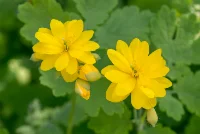Greater Celandine (Chelidonium majus)
/The dainty yellow flowers of Greater Celandine (aka "swallow") bloom when swallows return from winter nesting and die when the birds head south again. A member of the Poppy family, the medicinal use of the plant dates back to ancient Greece. It has been widely used in European herbal medicine through modern time for treatment of gallbladder disease and liver conditions.
As a homeopathic remedy, Chelidonium has produced favorable results for treating liver disorders. It has also been used with health conditions such as indigestion, heartburn, IBS, gout, osteoarthritis, warts and other skin diseases.
Greater Celandine is often prepared as an extract or tincture, depending upon the intended use. If extracts are not properly prepared and preserved, it can render the herb less effective or cause side effects. Also, if you don't use the appropriate dose of this herb for your particular health concern you could experience side effects ranging from rash to upset stomach and serious illness. Chelidonium is not appropriate for everyone. It is important that a healthcare practitioner provide you with the appropriate dose and quality of this herb.
Recent debate about the liver-protective versus potential toxic effects of Chelidonium majus has renewed the medical community's interest in this plant. Interactions have been found when Chelidonium is taken with Tylenol or Erythromycin or other drugs that stress the liver.
Image Attribution: Bogdana_Severyn/bigstockphoto.com
References

